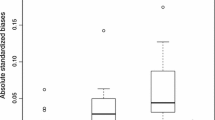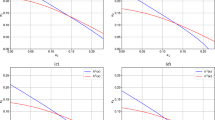Abstract
This paper applies stochastic control theory to the Grossman model of investment in health to characterize the case of a serious illness, i.e., one that permanently reduces the individual’s stock of health capital. Health itself is modelled as a stochastic variable, whose variation over time is determined partly by a deterministic factor and partly by a random factor with a Poisson distribution. After setting out the equations for the deterministic and stochastic approaches, phase diagrams illustrate how the introduction of uncertainty alters the model. The framework is also used to consider the effect of the introduction of a vaccine.





Similar content being viewed by others
Notes
Recognition of the importance of uncertainty has, of course, been a key element in health economics since Arrow (1963).
Longer periods of illness could be thought of as the result of autocorrelation in the drawings from the distribution of germ exposure.
This is a simplification that is common to the literature, see Cropper (1977) and Grossman (1972) for example. In principal, it would be fairly straightforward to make income in any period depend on the stock of health capital in that period. But this would add a degree of mathematical complexity without adding to the analysis of the question of interest here, which is the impact of uncertainty on the investment decision. One obvious extension of the present model would be to make the impact of health capital on income a random variable, giving us a two-stochastic state variable problem.
For an extension of the Grossman model to the case including financial assets, see Muurinen (1982).
Thus, sale of organs is excluded from our model.
If the optimal trajectory were to reach the horizontal axis before the end of the planning period, there would be an interval at the end of the individual’s life in which she made no deliberate attempt to affect her stock of health capital, instead allowing it to decline at the natural rate of depreciation, δ. In terms of the phase diagram, she would be sliding to the left along the horizontal axis until the end of the planning horizon. This would affect our later analysis only in the case where a serious illness struck after I reached zero. The drop in her health capital resulting from an illness in this range might take H far enough below her optimal level to prompt her to raise I above zero again, for some period of time.
We assume her postillness stock of health capital is so low that an individual who was born healthy would never run her health capital down to that level as part of an optimal plan.
We are, remember, assuming that her optimally chosen terminal health stock at the end of the first period will be greater than the level to which it has fallen at the beginning of the second period. Otherwise, it would appear that the illness could actually increase her stock of health capital.
For an autonomous equation, this term will not be present.
One obvious extension is to make T stochastic.
See Ferguson and Lim (1998).
The Ito derivative need only be used to replace the time derivative of a stochastic variable. The remaining derivatives in a model, which do not involve time directly, can still be taken in the usual way. In the finite horizon case, the individual would initially be following a trajectory slightly below the stable branch to the equilibrium because optimality requires I reaching 0 by the end of the (finite) horizon.
In a finite horizon problem she would jump to a trajectory below the stable branch because those are the only trajectories open to her which will reach I=0 in finite time. The shorter her remaining planning horizon (i.e., the later in life the illness strikes), the less the upward jump in I because the older she is the less time she has left and the sooner the optimal trajectory has to reach the horizontal axis.
For another model analysing the effects of the introduction of a vaccine in a Grossman model, see Auld (2003).
For example, an announcement today to the effect that a vaccine has been developed and will be available a year from today.
What matters is the magnitude of the loss of utility that results from the loss of health, which could be very large if H was initially small.
The equations for the continuous time stochastic optimization problem of investing in financial assets are set out by Merton (1971).
References
Arrow KJ (1963) Uncertainty and the welfare economics of medical care. Am Econ Rev 53(5):941–973
Auld MC (2003) Choices, beliefs, and infectious disease dynamics. J Health Econ 22(3):361–377
Clarke H, Reed WJ (1994) Consumption/pollution tradeoffs in an environment vulnerable to catastrophic collapse. J Econ Dyn Control 18(5):991–1010
Cropper ML (1977) Health, investment in health, and occupational choice. J Polit Econ 85(6):1273–1294
Dardanoni V, Wagstaff A (1990) Uncertainty and the demand for medical care. J Health Econ 9(1):23–38
Ehrlich I (2000) Uncertain lifetime, life protection and the value of life saving. J Health Econ 19(3):341–368, [Erratum: J Health Econ (2001), 20(3):459]
Ferguson B, Lim GC (1998) Introduction to dynamic economic models, 1st edn. Manchester Univ. Press, Manchester
Grossman M (1972) On the Concept of health capital and the demand for health. J Polit Econ 80(2):223–255
Johnston RJ, Sutinen JG (1996) Uncertain biomass shift and collapse: implications for harvest policy in the fishery. Land Econ 72(4):500–518
Merton RC (1971) Optimum consumption and portfolio rules in a continuous-time model. J Econ Theory 3(4):317–413 [Reprinted in Merton RC (1992) Continuous-Time Finance Blackwell, Oxford, pp. 120–165]
Muurinen JM (1982) Demand for health: a generalized Grossman model. J Health Econ 1(1):5–28
Picone G, Uribe M, Wilson RM (1998) The effect of uncertainty on the demand for medical care, health capital and wealth. J Health Econ 17(2):171–185
Pindyck RS (1982) Adjustment costs, uncertainty, and the behavior of the firm. Am Econ Rev 72(3):415–427
Pitchford J (1991) Optimum response of the current account when income is uncertain. J Econ Dyn Control 15(2):285–296
Acknowledgements
We thank two anonymous referees and Paul Grootendorst for their helpful comments and suggestions. The paper also benefited from the discussions with the participants at the Canadian Health Economics Study Group meeting in Banff Alberta.
Author information
Authors and Affiliations
Corresponding author
Additional information
Responsible editor: Alessandro Cigno
Rights and permissions
About this article
Cite this article
Laporte, A., Ferguson, B.S. Investment in health when health is stochastic. J Popul Econ 20, 423–444 (2007). https://doi.org/10.1007/s00148-006-0068-9
Received:
Accepted:
Published:
Issue Date:
DOI: https://doi.org/10.1007/s00148-006-0068-9




